Safeguarding the blue heart of Seychelles
We are thrilled to announce that D’Arros Island and St Joseph Atoll in Seychelles are officially protected!
As the Save Our Seas Foundation (SOSF), we are excited to announce that waters surrounding D’Arros Island and St Joseph Atoll in Seychelles have been declared marine protection areas as part of the nations larger Marine Spatial Plan Initiative. D’Arros Island has been declared as it’s own Zone 1 (no extractive use), with St Joseph Atoll part of a larger Zone 2 (conditional use).
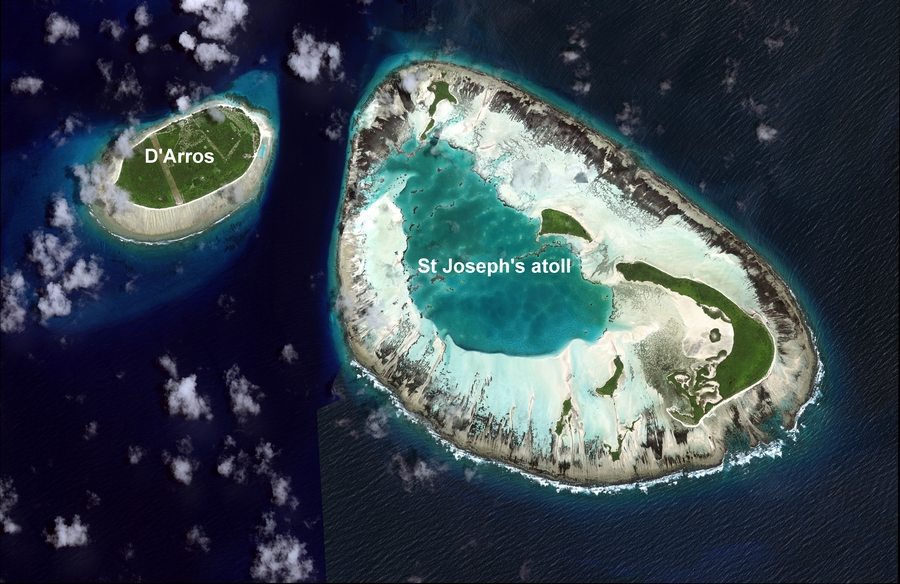
Aerial view of D’Arros Island and St Joseph Atoll. Image © Google Maps | Google
The D’Arros Research Centre (SOSF-DRC) was established in 2004 and since taking over its management in 2012, our core priority has been attaining protection for the abundant marine life surrounding the islands. Achieving this goal has required many years of scientific research, restoration work and collaboration with the Government of Seychelles and we are overjoyed that this pocket of near-pristine habitat will be preserved for years to come.
‘D’Arros is my favourite place in the world and I am delighted to welcome greater security for the marine habitats of this beautiful archipelago,’
says our CEO, Dr James Lea.
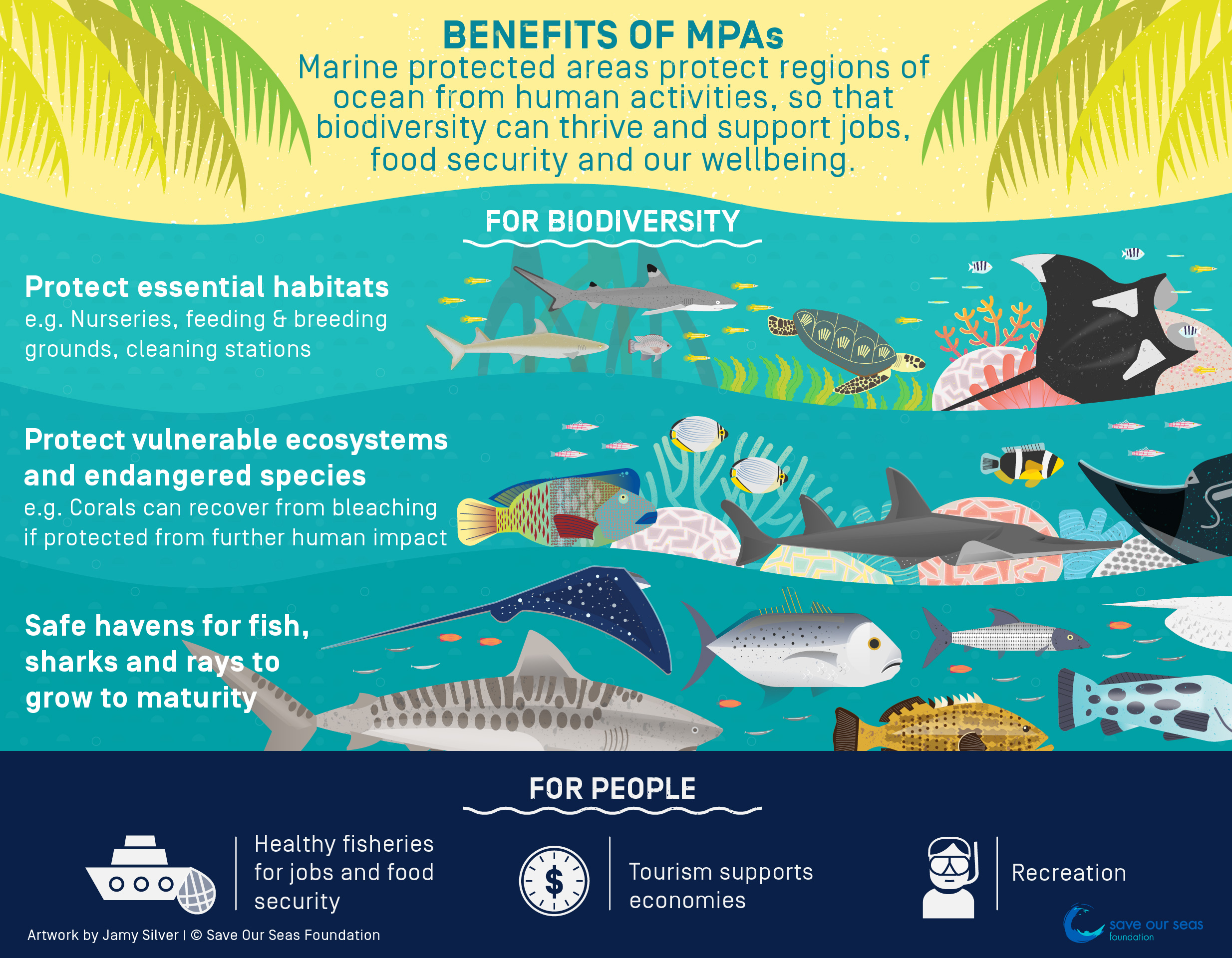
Marine protected areas (MPA’s) are essentially underwater ‘reserves’ where the marine life and their habitat are protected from various human activities. By creating these protected areas, the wildlife is able to thrive and these healthy populations will hopefully spill-over into the oceans and contribute to healthy fish-stocks for food supply, and boost the economy through eco-tourism and healthy fisheries. Illustration by Jamy Silver | © Save Our Seas Foundation
Although the designation was announced today, the 26th of March 2020, the waters surrounding D’Arros Island and St Joseph Atoll have been an important sanctuary for marine life for decades. The islands are home to one of Seychelles’ longest-running turtle-monitoring programs and this is the only location in Seychelles that supports nesting and foraging populations of both Endangered green and Critically Endangered hawksbill turtles – it may represent the most important location for hawksbills in the entire Western Indian Ocean!
Our research has also shown that this is an important home for a large population of manta rays, that feed on zooplankton around the islands during the day and then deliver nutrients to D’Arros’ coral reefs when they return there to visit cleaning stations. These reefs host massive fish diversity and during a rapid biodiversity assessment in 2017, SOSF-DRC researchers recorded more than 514 different fish species in just 19 days. We even discovered a new species: a dwarfgoby named Eviota dalyi.
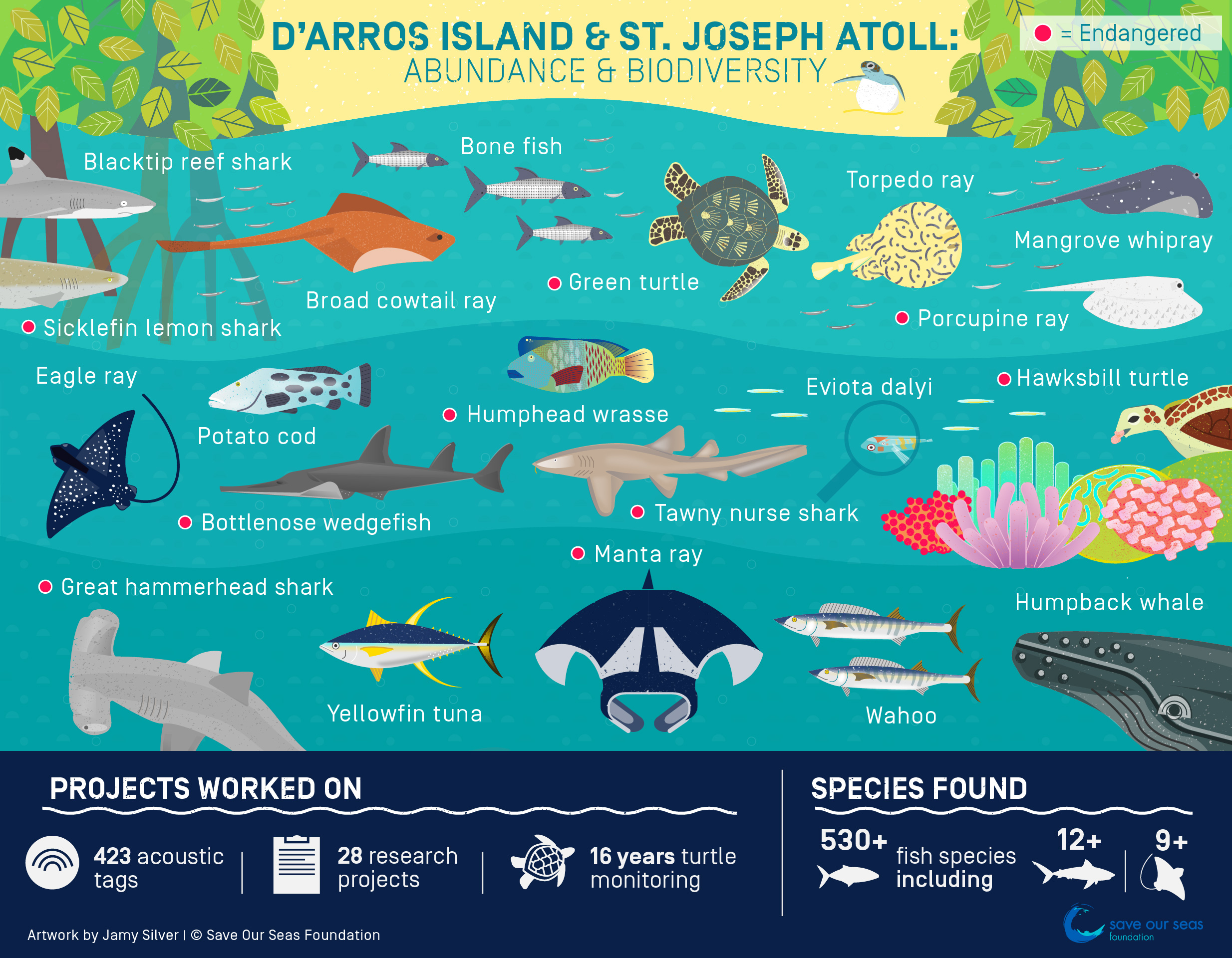
D’Arros Island and St Joseph Atoll have been visited by over 530+ various fish species. Some of these species pass through the waters from time to time, while others take up residence in the coral reefs and mangrove forests. We can proudly boast that the waters surrounding the islands are a sanctuary for a number of endangered and critically endangered species. Infographic by Jamy Silver | © Save Our Seas Foundation
This rich biodiversity, coupled with minimal human impact from fishing or pollution, has created a kind of immune system for the reefs, making them especially resilient. A coral bleaching study that began just before worst global bleaching event in history, showed that nearly 50% of the hard corals surrounding the D’Arros and St Joseph archipelago were bleached in 2016, but over time, these corals showed remarkable recovery.
St Joseph Atoll, nearby, is one of only six atolls in Seychelles, and is the only one to have an uninterrupted reef flat at low tide, which heavily restricts access to larger animals. This provides a uniquely protected nursery habitat for numerous young and vulnerable animals, that can feed on the sand flats when the tide goes out and find shelter between vast mangrove roots when it comes in again. Our studies have shown that this has significant benefits for blacktip reef shark pups. Baby sharks born at this atoll start feeding early, and remain stronger during their early months, when they are most vulnerable. The lagoon is also a haven for three species of baby stingrays.
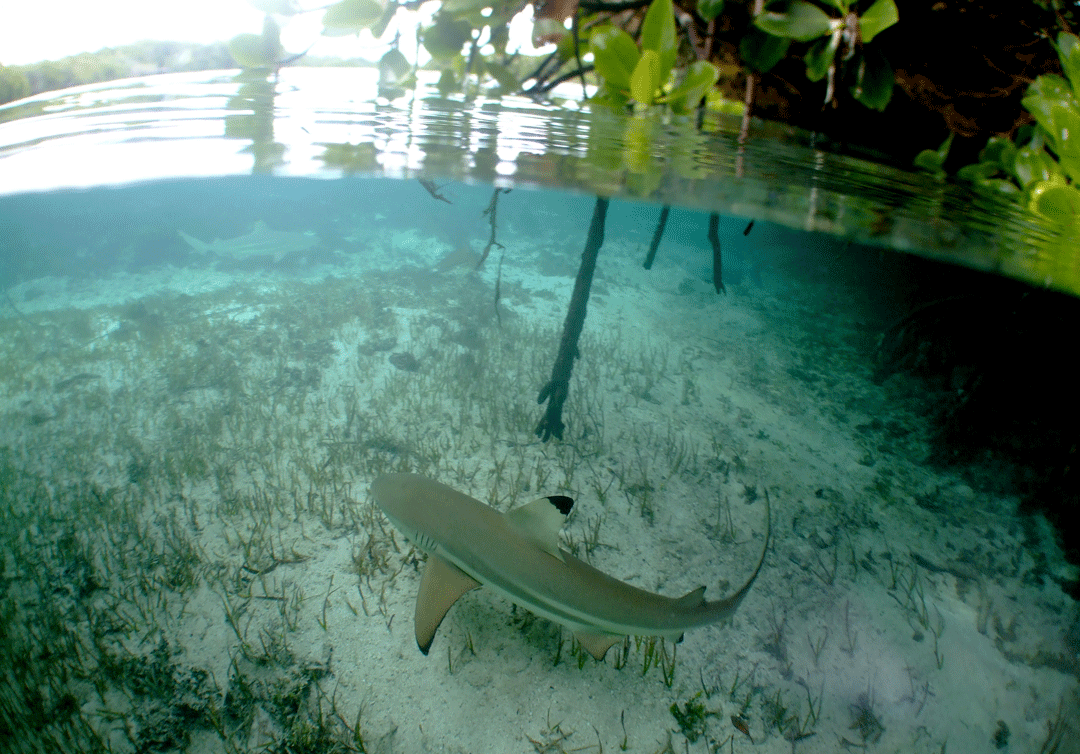
A young blacktip reef shark seeks sanctuary amongst the roots of an indigenous mangrove forest. Photo © James Lea
It is because of these vast ecological riches, and the fact that they have been so clearly demonstrated by the research we have shared from the SOSF-DRC, that Seychelles’ government has made the decision to include D’Arros and St Joseph as part of their promise to protect 30% of the Seychelles’ ocean space by 2020. “We are developing a comprehensive marine spatial plan to ensure that future generations of Seychellois can enjoy the incredible marine biodiversity in our waters,” said President Danny Faure during the historic speech he delivered just over a year ago.
We are equally dedicated to ensuring that young Seychellois can experience the wonders of D’Arros and St Joseph. We hope to inspire these children to become custodians of their natural heritage through environmental camps held at the archipelago, giving them the opportunity to engage with abundant wildlife and with our SOSF-DRC researchers.
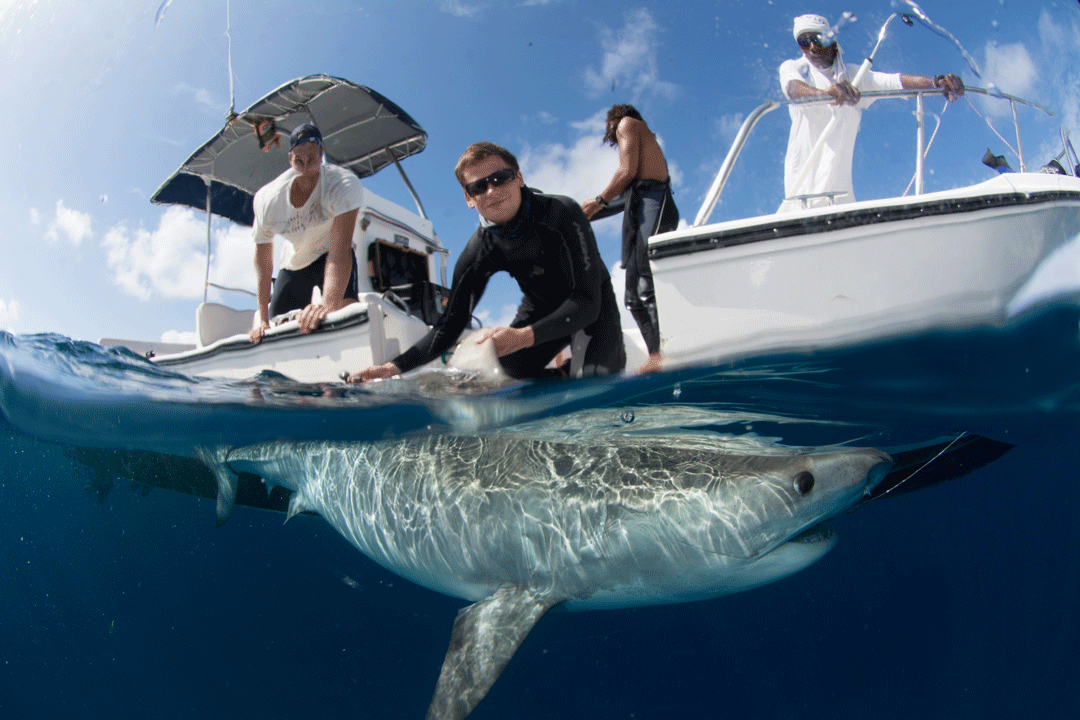
Dr James Lea fits a tiger shark with an acoustic and satellite tag as part of a study to monitor the movements of these sharks in Seychelles waters and the surrounds. Photo by Ryan Daly | © Save Our Seas Foundation
‘Having the chance to work alongside passionate people… it has encouraged me to know that there are people out there trying to do their best to protect what little we have left,’
said Carol Hoareau, who attended one of the D’Arros Experience camps in 2014.
It is our wish that this special place will be safeguarded for all generations of Seychellois to come and that these new reserves will support the regional recovery of fish and wildlife stocks, providing future income across Seychelles from fishing and ecotourism.
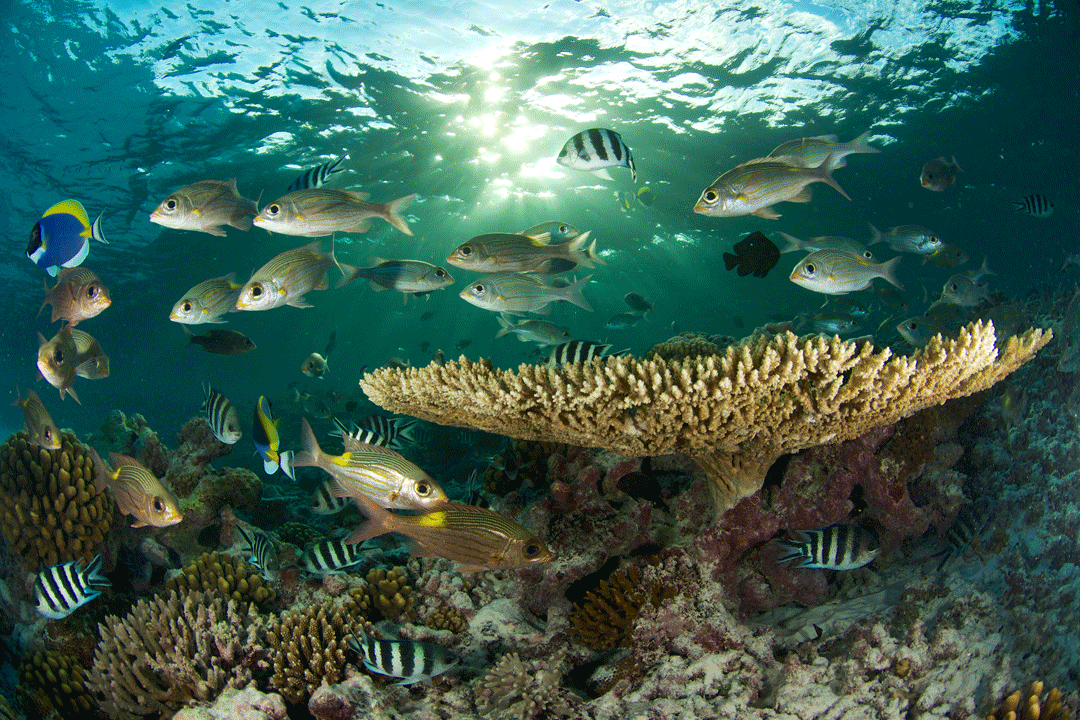
A healthy and vibrant coral reef teaming with life found in the waters surrounding D’Arros. Photo by Rainer von Brandis | © Save Our Seas Foundation
